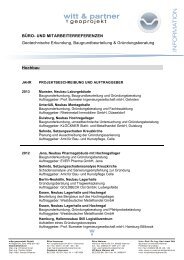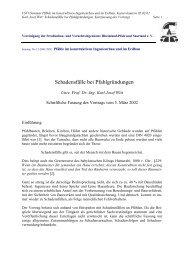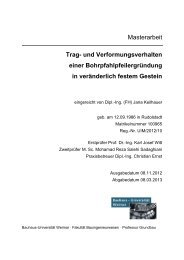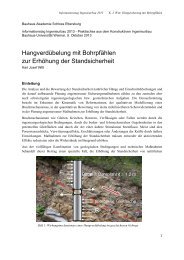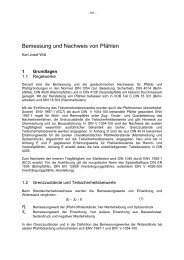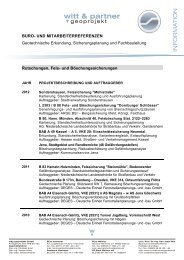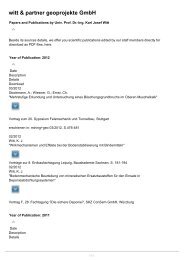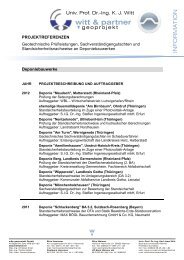A Static Analysis of Hydraulic Heave in Cohesive Soil - witt & partner ...
A Static Analysis of Hydraulic Heave in Cohesive Soil - witt & partner ...
A Static Analysis of Hydraulic Heave in Cohesive Soil - witt & partner ...
You also want an ePaper? Increase the reach of your titles
YUMPU automatically turns print PDFs into web optimized ePapers that Google loves.
and material properties <strong>of</strong> the wall, i. e. stiffness and<br />
strength.<br />
The most important result <strong>of</strong> this analysis is the<br />
documented <strong>in</strong>fluence <strong>of</strong> the flow direction on the<br />
probable shape <strong>of</strong> the failure body. In case <strong>of</strong> an almost<br />
cont<strong>in</strong>uous flow without any <strong>in</strong>fluences due to redirection<br />
on layer planes or constructions a flat soil will be uplifted.<br />
This result corresponds with observations made <strong>in</strong> similar<br />
cases. On the other hand the results <strong>of</strong> the sheet pile wall<br />
example show the strong <strong>in</strong>fluence when chang<strong>in</strong>g the<br />
flow net shape. In such cases the shape <strong>of</strong> the failure body<br />
will significantly be <strong>in</strong>fluenced by the permeability <strong>of</strong> the<br />
percolated soils and the thickness <strong>of</strong> such layers.<br />
The more concentrated a percolation occurs the th<strong>in</strong>ner<br />
the failure body shape will be.<br />
IV. VISUALISING OF THE FAILURE INITIATION<br />
Experiments were executed to visualise the failure<br />
process and to characterise the failure type <strong>in</strong> dependence<br />
on the cohesion. Furthermore the experiments should<br />
document the <strong>in</strong>itiation and the development <strong>of</strong> the failure<br />
process. The experimental study should demonstrate<br />
weather the failure <strong>in</strong> cohesive soil is more characteristic<br />
for liquefaction or for wedge uplift and how large is the<br />
value <strong>of</strong> the limit<strong>in</strong>g parameter cohesion c B between both<br />
failure types.<br />
The experimental equipment simulates a sheet pile wall<br />
as support<strong>in</strong>g element on an excavation. To m<strong>in</strong>imize the<br />
necessary potential difference with<strong>in</strong> the experimental box<br />
different material were <strong>in</strong>stalled on the upstream and the<br />
downstream side. The embedd<strong>in</strong>g <strong>of</strong> the wall on the<br />
upstream side consists <strong>of</strong> 10 mm clay and 90 mm coarse<br />
gra<strong>in</strong>ed filter material. On the downstream side the wall is<br />
fully embedded <strong>in</strong> the cohesive clay (see Fig. 7.) By<br />
<strong>in</strong>stall<strong>in</strong>g different permeable material on the different<br />
sides <strong>of</strong> the wall most <strong>of</strong> the seepage forces were activated<br />
on the downstream side with<strong>in</strong> the clay. Bažant carried out<br />
<strong>in</strong>vestigations (see [1]) to show that the deformations on<br />
the upstream side <strong>of</strong> a wall are comparatively smaller than<br />
those on the downstream side when reach<strong>in</strong>g hydraulic<br />
heave. The embedd<strong>in</strong>g <strong>in</strong> the clay can be <strong>in</strong>stalled as small<br />
as possible thus very small deformations are expected on<br />
the upstream side <strong>of</strong> the wall.<br />
After <strong>in</strong>stallation <strong>of</strong> the soil layer a saturation <strong>of</strong> the<br />
soils have to be executed. To <strong>in</strong>crease the velocity <strong>of</strong><br />
saturation the hydraulic stress level on both sides <strong>of</strong> the<br />
wall was cont<strong>in</strong>uously raised and held constant at a<br />
Figure 7. Experimental box with <strong>in</strong>stalled clay and filter material<br />
Figure 8. Result after failure (white l<strong>in</strong>e = slip plane)<br />
backpressure <strong>of</strong> approximately 50 kN/m².<br />
Due to a follow<strong>in</strong>g long term raise <strong>of</strong> the hydraulic head<br />
on the upstream side <strong>of</strong> the wall an expansion <strong>of</strong> the soil<br />
cont<strong>in</strong>uum on the downstream side were observed. This<br />
process was followed by the <strong>in</strong>itiation <strong>of</strong> a vertical crack<br />
at the end <strong>of</strong> the wall foot on the downstream side. In a<br />
constant stress state the first crack were enlarged and<br />
f<strong>in</strong>ally lead to a failure <strong>of</strong> the soil. Due to an <strong>in</strong>crease <strong>of</strong><br />
the act<strong>in</strong>g stress level the crack also <strong>in</strong>creases. F<strong>in</strong>ally the<br />
crack reaches the downstream surface. The consequence<br />
was a short term uplift <strong>of</strong> a discrete soil clod followed by a<br />
compensation <strong>of</strong> the different stress levels on both sides <strong>of</strong><br />
the wall. Dur<strong>in</strong>g the compensation the clod was destroyed<br />
and teared apart <strong>in</strong>to small aggregates and even particles<br />
<strong>of</strong> the soil. The result after the compensation is shown <strong>in</strong><br />
Fig. 8.<br />
The failure due to hydraulic heave occurs <strong>in</strong> the strong<br />
cohesive clay as a wedge mechanism. The <strong>in</strong>itial crack<br />
was realised when a total hydraulic stress difference <strong>of</strong><br />
25 kN/m² forces the soil. That is the excess hydraulic head<br />
related to the base <strong>of</strong> the wall was about ∆h u = 2 m. Aim<br />
<strong>of</strong> the experimental work is not to determ<strong>in</strong>e the stress at<br />
limit state, but to study the development <strong>of</strong> the failure <strong>in</strong><br />
cohesive soils. Nevertheless the first results correspond<br />
with formula 6.<br />
Fig. 8 shows the shape <strong>of</strong> the failure clod <strong>in</strong> a cross<br />
section. Regard<strong>in</strong>g the change <strong>of</strong> the failure body depth<br />
due to the <strong>in</strong>itial vertical crack the width <strong>of</strong> the failure<br />
body is about m ≈ 2. The result doesn’t correspond with<br />
the expected value <strong>of</strong> m = 1/2. Reason for the <strong>in</strong>vestigated<br />
shape could be the soil <strong>in</strong>stallation technique, which<br />
produces a horizontal layered soil cont<strong>in</strong>uum and<br />
anisotropic conditions concern<strong>in</strong>g density and<br />
permeability. When <strong>in</strong>stall<strong>in</strong>g the soil <strong>in</strong> a way that quasi<br />
isotropic properties are existent dur<strong>in</strong>g the experiment a<br />
change <strong>of</strong> the failure body shape is expected.<br />
As th<strong>in</strong>gs will develop another question has to be<br />
answered. How does the stress state at the wall base<br />
change the soil conditions dur<strong>in</strong>g <strong>in</strong>creas<strong>in</strong>g <strong>of</strong> the total<br />
potential difference Thus a comparison <strong>of</strong> the failure<br />
time with the change <strong>of</strong> pore water pressure on the wall<br />
foot will be estimated.<br />
Alternatively to the static approach (formula 6) the<br />
<strong>in</strong>itiation <strong>of</strong> cracks can be def<strong>in</strong>ed as limit state. This<br />
approach matches the conditions <strong>of</strong> hydraulic fractur<strong>in</strong>g to<br />
def<strong>in</strong>e a limit state. From a mechanical po<strong>in</strong>t <strong>of</strong> view the



